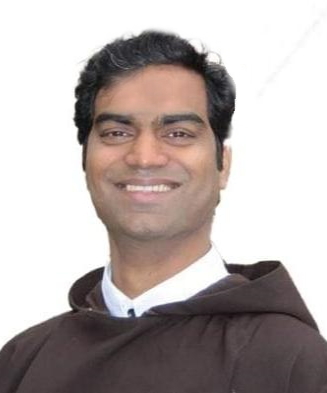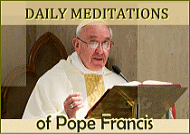“The bread … for the life of the world” (Jn 6:51)
Some years back, I was staying at the Salesian community in Florence, Italy, for a few weeks. Florence is known for its art and architecture. Following that great tradition, the Salesians in Florence have a beautiful modern fresco-type of a mural in the background of the sanctuary of their community chapel. Paintings are meant to be looked at; however, let me attempt to describe it to you so as to draw a point of reflection from it. At the center of the mural is the actual tabernacle with the Holy Eucharist. To the right of the tabernacle is the image of Mary. She is seated on a parapet affectionately cuddling the baby Jesus. Her eyes are fixed on the tabernacle. Just behind Mary are four men representing the patriarchs and the prophets of the Hebrew Scriptures. Moses is very easily recognizable as he holds the tablets of the Ten Commandments; there are others holding some scrolls. On the other side of the mural is Mother Teresa. She too holds a baby in her hands with much compassion. Her eyes are fixed on the baby. Mother Teresa is accompanied by a group of young people, among whom stands Don Bosco, the founder of the Salesians. Between these two groups of people – Mary and the patriarchs, and Mother Teresa and the crowd of young people – on either side of the tabernacle are two angels in a posture of humble adoration, while they point at the two groups of people.
While still in Florence, I could not help but spend some hours contemplating that mural. I thought it captures quite well the meaning of the mystery of the Eucharist.
These five Sundays in the ordinary time (from 17th Sunday to the 21st) we continue to listen and meditate on John 6. Thus, the Liturgy of the Word invites us to contemplate the mystery of the Eucharist. “I am the living bread which has come down from heaven. Anyone who eats this bread will live forever; and the bread that I shall give is my flesh, for the life of the world” (Jn 6:51). I would like to invite you to reflect on this verse even as you try to imagine that mural that I have just described.
“I am the living bread which has come down from heaven”: The Mystery of Incarnation
On one side of the wall painting is Mary in the company of personages from the Hebrew Scriptures. She holds her infant Jesus, as she gazes at the tabernacle. This image powerfully creates the link between the mystery of Incarnation and the Eucharist: “And the Word became flesh and dwelt among us” (Jn 1:14). “Something which has existed since the beginning, which we have heard, which we have seen with our own eyes, which we have watched and touched with our own hands, the Word of life – this is our theme” (1Jn 1:1). Jesus of Nazareth, the word made flesh, offers his own flesh in the Eucharist to remind us of the love of God, made visible and tangible in the incarnate Jesus. In so doing, he invites us to commune with him. When we respond to that invitation and consume that flesh, God becomes ‘incarnate’ in us, and we become one with him. The Eucharist makes the mystery of incarnation real even today for those who receive it with that intention.
And this is the fulfilment of the promises of the Lord God in the Hebrew Scriptures. The first readings of these Sundays have been inviting us to look at some of the experiences associated with food and drink for the people of Israel. Last Sunday, we heard read how the Lord God fed the people of Israel with manna and quails. In the first reading of today, we see how Elijah was fed by an angel with scones and water. In both these stories the God-given food is meant to strengthen
the recipients for the journey towards the mountain of God. And at that mountain will be an intimate encounter with God.
This intimacy is made so powerfully possible for us today in the Eucharist. And therefore, it is only fitting that the mural in the Salesian house at Florence suggests that the Eucharist is the continuation of the mystery of incarnation, which is also the fulfilment of the promises of the Hebrew Scriptures.
“Anyone who eats this bread will live forever”: The mystery of the Eucharist
These mysteries are not merely abstract articles of faith in the creed or the tradition of the Christian community. They are tangible; they offer us the possibility for a personal experience of the Transcendent in the context of the community.
The mystery of the Eucharist offers us a possibility of an experience of transcendence – to experience something beyond the here and now. It offers us a foretaste of the bliss of heaven – being with God for ever. To allow the life of God to flow in us! In the responsorial psalm, we responded: “Taste and see that the Lord is good.” Those words call us to a concrete experience of what is beyond the senses.
In the mural of Florence, the presence of the angels around the tabernacle reminds us of the transcendental nature of the Eucharist. At the same time, the Eucharist in the tabernacle is something we can see, touch and taste. And fittingly, the angels point us to something historical and existential.
“The bread… for the life of the world”: The mystery of continuing work of redemption
One reason why I am proud to be a Catholic is that as a community we are a very concrete people: both in our experience of faith and the expression of it. Our experience of God is mediated also through the sacraments. In the context of the present reflection, our attention is on the sacrament of the Eucharist. And that experience of God is expressed in our daily lives in concrete situations. This is so tangibly seen in the numerous charity works that the church is involved in all over the world. Consider for instance that over 25% of all the care that is offered to people living with HIV in the world is carried out by Catholic groups and agencies. You could also consider the tremendous work of Catholic workers and ministers worldwide in poverty alleviation, in the education sector and health care. These are but expressions of our experience of the Bread of Life that offers life to the world. By means of these expressions, we share in Christ’s continuing work of redemption. No wonder, Catholics such as Mother Teresa and Bishop Belo could be awarded the Nobel Peace Prize! Their expressions of faith in concrete situations have offered life to the world. It is well known that even amidst her busy schedule of charity, Blessed Mother Teresa spent two hours every day in front of the Eucharist. She truly lived a Eucharistic spirituality, that was, at the same time, incarnational and redemptive.
May our participation in this Eucharistic celebration invite us to share in the life of God, and then to pass on that life to the world. Let this celebration enable us to live a Eucharistic spirituality.
Fr. Franco Pereira, S.D.B.


